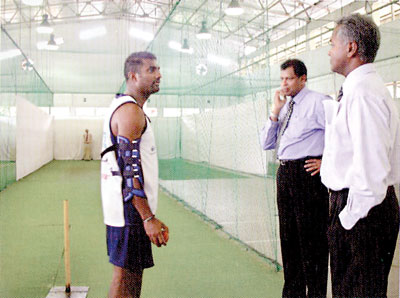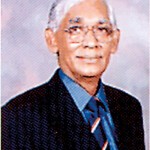The Murali splinter saga
View(s):Cricket writer, historian and former Bloomfield left arm spinner Mahinda Wijesinghe believes that there was justification on the claim that the Lankan champion spinner Muttiah Muralitharan did not bend his arm or straighten his elbow more than the ICC stipulated norms through his career.
It is no secret that even now there are scores of eminent past cricketers even in the higher echelons of decision making who believe that the ICC bent its laws to accommodate the Lankan off spinner and it was case of tolerance to curb a volatile situation in cricket rather than bowlers action accepted as legitimate.

Murali with his arm brace talking to Kushil Gunasekera and the then President of SLC Mohan de Silva. At the end of the net is Mahinda Wijesinghe waiting for Murali to bowl at him
However, Wijesinghe says that the ‘Brace’ test that he pioneered on Muralitharan went on surprise even Muralitharan’s biggest critics and on seeing the bowler in action under those conditions bowling all varieties he generally delivers in match conditions, they finally tended to believe that they had no qualms about the legality of his bowling action.
In one of his narrations Sri Lankan born Australian cricket author Michael Roberts defined the whole episode in the following manner “Despite the provisos, it could be said that Muralitharan was under the gun once again because of the widespread prejudices against him held in antipodean circles. However, these antipathies were now at play in a context where the ICC had moved away from its hoary conservatism and was reaching for some pragmatic solution to the growing realisation that most bowlers threw the ball in some measure.
Thus, in overview it can be said that the fresh charge against Muralitharan occurred in the midst of swirling debate within the inner corridors of power. It even appears that as far back as September 2003 David Richardson, Secretary to the ICC and a former wicker-keeper batsman, had recommended an alteration in the rule of thumb to a standardised ceiling of 15 % flexion for all bowlers.
Then Mahinda Wijesinghe in the same narration says “As far as I can decipher matters, the research paper by Portus in 2003 seems to have been a significant influence directing Richardson to this conclusion — to judge from the UWA summary (2004) of its arguments. It is vital to note that the contents of these debates were mostly hidden from the cricketing public. Before proceeding to the outcome of this vital thread of development one must return to another set of events.”
This is the story of ordinary people taking extraordinary initiatives to save Muralitharan’s doosra with the help of some television companies. These men have been depicted elsewhere as “unsung heroes”: they are Mahinda Wijesinghe, Kushil Gunasekera, Dr. Mandheep Dhillon and Glucka Wjesuriya. To this list one should add more famous individuals, namely, Ravi Shasthri, Tony Greig and Mark Nicholas because of their endeavours behind the scene or work in front of the camera.

Mahinda Wijesinghe
The first venue was Colombo and involved an unholy combination between Murali’s Manager, Kushil Gunasekera, Dr. Mandeep Dhillon of the Apollo Hospital and Mahinda Wijesinghe, cricket historian and former cricketer.
Dhillon had approached Gunasekera and told him he wished to help Muralitharan. Gunasekera phoned Wijesinghe. Let a note from Mahinda Wijesinghe take up the tale.
Mahinda Wijesinghe explained – “At preliminary discussions at the SLC headquarters took us nowhere. It was my view that the ICC was drawing red herrings across the track by camouflaging and confusing the issue with ‘flexion’ and ‘degrees’ and a whole host of technical terms. On earlier occasion CB Fry when accused of ‘chucking’, bowled with a splint on his elbow in the nets and proved the point that he was not bending the elbow at the point of delivery.
“Dr. Dhillon and I were elated with this idea. He immediately asked for a brace to be brought from their stores. They were able to unearth only an ankle brace. However Dr. Dhillon put it on Murali’s elbow and asked him to go through the motions. Murali tried it and said that it is no problem!
Next we booked the Sri Lanka Cricket Foundation indoor cricket nets at the NCC grounds and ensured that nobody would be there. (By the way, it was I who designed the SLCF indoor nets when I was the first Executive Secretary). That day, in the presence of Mohan de Silva (the then Sri Lanka Cricket president), Dr. Dhillon, Murali and myself the experiment began. It was also being videoed. And Murali bowled at me!!! He bowled without any problem wearing the brace.
It was later that Dr. Dhillon manufactured a brace made of plaster with steel splints and Murali gave a demonstration at Lord’s (nursery grounds for Channel 4?) with Mark Nicholas as compete and with cameras focused from all angles. And Murali bowled his whole range. I still remember having seen the video of how Nicholas, after the demo held the brace in his hands and said: “Cross my heart, you cannot bend this”. In other words, there was no problem about ‘chucking’.
“Colombo being low in the pecking order of world-cricketing power, it was in England that the critical second stage occurred. A public demonstration of Muralitharan’s unique attention and the legality of the doosra, through a high-profile TV documentary produced by Channel Four was rendered possible by the initiative of Glucka Wijesuriya, a Sri Lankan migrant and lawyer who happens to be a friend of Sri Lankan cricket and a friend of Muralitharan. This was a major breakthrough.
“It was consolidated later at Premadasa Stadium though the good offices of ESPN and Ravi Shastri during a series of international matches in Sri Lanka when Muralitharan bowled to Michael Slater, one of the commentators, under the eye of several cameras. Slater is an open book and his acceptance of the evidence, with Shasthri already on board in the background, must surely have reverberated through the airwaves, especially among Indian cricket fans who had not taken the position of some Australians and who now had one of their own, Dr. Dhillon, to add to their list of heroes.
It was a brace designed by Dhillon that had featured so prominently in the Channel 4 and ESPN documentary films. The TV presentation by Channel 4 in July 2004 was preceded by a newspaper article in the Daily Telegraph from Mark Nicholas which clarified the results of Muralitharan bowling with a brace.
“There is no way an arm can be bent, or flexed, when it is in this brace. I am sure of this because I tried. All three balls reacted in the same way as when bowled without the brace. ‘They were not howled quite so fast because the weight of the brace restricts the speed of Murali’s shoulder rotation, but the spin was still there. Murali has a quick arm, as quick as most fast bowlers. This, along with his strong wrist, imparts dramatic energy on the ball.”
“By coincidence the ICC was moving towards a resolution of the conundrum surrounding bowling actions. One step was a media release later in the same month, July, that ran: “The ICC will hold a media briefing during tomorrow’s play at the second power Test at Edgbaston (Thursday 29 July), to confirm the arrangements being put in place during the ICC Champions Trophy 2004 concerning the filming of slow bowlers and extended use of TV technology for umpires. ‘The briefing will include an explanation of the slow bowler filming programme being carried out by human movement specialist Dr Paul Hurrion for the ICC.”
Hurrion’s research continued during the Champions Trophy in September and revealed that “thirteen of the 23 bowlers filmed broke the current levels of tolerance introduced in 2001 – [namely] five degrees for spinners, seven and a half degrees for medium-pacers and 10 degrees for fast bowlers.”
‘The conclusive step was later the same year when the biomechanical experts Elliott, Porrus and Hurrion were assembled in Dubai to make their visual and verbal reports to the ICC’s Advisory Panel on Illegal Deliveries. This panel was an august one made up of former cricketers of relatively recent vintage and included Angus Fraser, Michael Holding, Aravinda de Silva and John Reid.”


